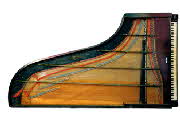
THE PERIOD PIANO COLLECTION
Performing - Studying - Exhibiting - Conserving
A 501(c)3 Non-Profit Corporation email contact
Bill Shull, RPT, M.Mus. Founder and President
610 Amigos Dr C, Redlands, CA 92373 909 796-4226 PERIOD PIANO CENTER SINCE 2006
|
THE PERIOD PIANO COLLECTION Performing - Studying - Exhibiting - Conserving A 501(c)3 Non-Profit Corporation email contact Bill Shull, RPT, M.Mus. Founder and President 610 Amigos Dr C, Redlands, CA 92373 909 796-4226 PERIOD PIANO CENTER SINCE 2006 |
|
|
|
|
|
|
|
Expenses of the Period Piano Center: Current monthly costs for exhibit room and storage space rental: $1,660 Each donation averages $400 per piano for transportation and related costs, costs are sometimes up to $900. Piano Technicians Guild Annual Technical Institute Exhibit:This year the PTG St. Louis Convention cost was $3,284 Period Performance Events Costs for maintaining legal status and filings, as well as corporation insurance Total actual costs for the 2017 year exceed $20,000. OTHER NEEDS: Conference Attendance: Each year important conferences take place which the Period Piano Center President should attend, and occasionally exhibit and present at. Ongoing research costs: Research for the Steinway project and the Chickering project require archive work in various museums such as the Smithsonian in Washington, DC., the Strong Museum in Rochester, NY., the Wagner/Steinway Archives in New York City, NY., and many sites where pianos must be documented. These costs include flight and hotel, transportation and museum access fees. In addition, the pianos registries study requires research assistant support to permit significant hours at a microfilm machine converting registries to PDF documents. Documentation Site Visits Pianos of historical importance require site visits for thorough documentation Ongoing Building and Utilities Expenses Monthly storage and lease costs: The collection is currently located in 800 square feet of museum exhibit space, and in 5 storage units. Currently the exhibit area is a portion of the Shull Piano business, and benefits from the savings of a portion of rent. However, a building of 10,000 sq feet would easily be accommodated by Period Piano Center. The President is currently maintaining the website, which, in reality, requires a higher level of expertise than he possesses, both in terms of presentation and technical needs. The website should be developed and maintained by a website professional. It is particularly important to improve the online database www.historicalpianosociety.org to support the large contribution Period Piano Center could make to the community of piano researchers by faciliting the web sharing of piano documentation photos and data. Future Expenses 1. Museum Instrument Acquisitions All pianos have come from donations, but Period Piano Center has had to pass on excellent opportunities due to lack of funds. Your contribution to our acquisitions fund will make key acquitions possible. 2. Replica pianos Selected replica pianos from each period and style are needed, from a Christofori to a classical-era Walter, Rosenberger or Stein, an early Broadwood; early romantic period Pleyel, Graf, Bosendorfer, Erard, and mid-romantic period Erard, Boisselot. 3. Additional fortepianos and pianos across the span of time which would permit a complete historical display, from the 18th to the 21st century. In order to show our broad intention, we seek pianos from Silbermann to Stein to Broadwood, Graf and Streicher, to Pleyel, early and late Erard, Boisselot, early and late Broadwood; early American squares from Philadelphia and Boston, through quality larger squares of the 1860s to 1880s; giraffe and other tall uprights from the early 19th century; cocked hat grands from Chickering and others from the mid-19th century (and giraffe and cocked hat retro-designs of the late 19th century). 4. Fundraising Events: Presentations to potential donors in order to provide the necessary capital infusion to begin the ongoing work, in order to meet museum rent, payroll, documentation site visit, exhibit, grant-writing and acquisition costs. Eventually conservators, technicians, restoration specialists will be needed - the work is to large for one person. Why is this work important? To re-discover the music of the period; to preserve culture and musical heritage; to preserve and protect actual musical instruments themselves for study, without additional invasive and history-destroying activity. We recommend obtaining the DVD “Knowing the Score,” an extraordinary presentation on the importance of the period piano by renowned fortepianist and educator Malcolm Bilson. The Period Piano Center is working to make possible the redisovery of music on pianos built in the 19th Century. Documentation, restoration, conservation, performance, teaching - this will make possible for current and future generations of pianists the rediscovery of the music of Chopin, Liszt, Mendelssohn, Brahms...even Ravel and Debussy....on the pianos which they, themselves, heard their music on. Piano students, majors, and others will soon have opportunity to hear and play the music of Chopin, Mendelssohn and Liszt - as well as Debussy and Ravel - on the Erard these composers most often heard their music on, and composed for. Your contribution, large or small, will aid in this noble project. |
|
|
|